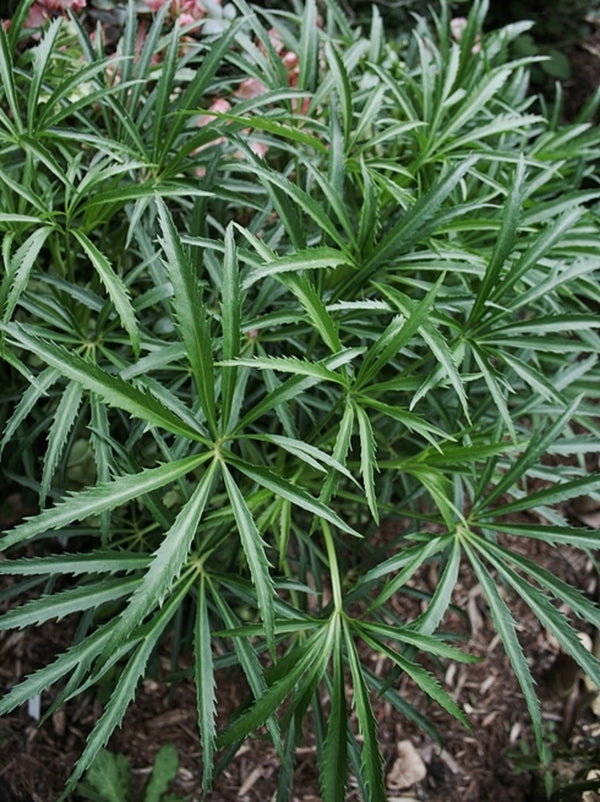Helleborus foetidus 'Leather and Lace'
Leather and Lace Bear Claw Lenten Rose
Item #: 10063
Zones: 6a to 9b
Dormancy: Evergreen
Height: 30" tall
Culture: Part Sun to Light Shade
Origin: Southeast Europe
Pot Size: 3.5" pot (24 fl. oz/0.7 L)
Helleborus foetidus 'Leather and Lace' started at Plant Delights Nursery as a couple of oddball seedlings we pulled out of our Helleborus foetidus 'Krenitsky' strain, and subsequently introduced as a strain in 2015. The dark, black-green foliage of what we subsequently named Helleborus 'Leather and Lace' is more deeply cut than any form of Helleborus foetidus we've ever grown. The 20" tall x 3' wide evergreen clumps are topped with the typical 10" tall candelabra-like terminal sprays of large green bells in winter. As with all Helleborus foetidus, well-draining soils is the key to success.
Maintenance:
The growth habit of Helleborus foetidus is quite different from the Lenten Rose, Helleborus x hybridus and the Christmas Rose, Helleborus niger and their near kin. Both Helleborus x hybridus and Helleborus niger produce both leaves and flower stalks directly from the subterranean crown of the plant. The crown of a plant is a compressed stem and is characteristic of many herbaceous perennials such as Hostas and Hemerocallis (daylily). In contrast, Helleborus foetidus has a substantial aboveground stem that averages 18 to 24" tall. Individual stems have a two year life span. They are produced in the spring and they are well clothed with their dark green palmately divided leaves. Come late fall numerous paler green bracts and flower buds start to form at the apex of the stem. Soon they become a foot tall candelabra of pendant green bells. The pale green glows in the winter garden, especially on a overcast day. What Helleborus foetidus lacks in colorfulness (nothing actually) it makes up for in its very handsome architecture.
By summer the seeds are mature and shed from the fruit as the fruit open. At this point the whole stalk has completed its life cycle and need to be cut to the ground, leaving the new vegetative growth. Do NOT be discouraged by the following information: Helleborus foetidus has more of a live fast, die young life cycle than Helleborus x hybridus and Helleborus niger, which seem to live forever. Helleborus foetidus tends to be a permanent addition to a garden even though individual plants might live for just three to five years, because there are enough seedlings to replace old plants. Seeds start to germinate in late fall, with additional germination through the winter. With good care a seedling can bloom in about one year, certainly in two. And they transplant readily so the gardener can plant them where they are wanted. Space the seedlings about a foot apart.
Natural Impact:
Helleborus foetidus belongs in every garden where winter interest is desired and this species can be grown. The three to four month winter floral display is very showy. It combines well with all other plants of winter interest whether other herbaceous perennials or flowering trees and shrubs such as Camellia or Prunus mume, or plants with colorful twigs. Year-round, Helleborus foetidus is a handsome foliage plant.
Growing Conditions:
Helleborus foetidus is a zone 7 plant. In colder areas the foliage is damaged by cold. It wants shade to part shade. It does not want to be exposed to hot, midday sun in the summer. Avoid soggy soil.
Nomenclature:
The specific epithet "foetidus" means foetid. For this reason some call this Hellebore the "stinking Hellebore". To most, its odor is only evident when working amongst the plant. It is not usually an odor one notices on the air. It is not one that will chase gardeners from the garden.



-
Other Attributes
Genus: Helleborus
Flower Color: Green
Leaf Color: Green
Bloom Time: Winter
Container Role: Fillers
Garden Themes: Cottage Garden Plants
Other: Fragrant Foliage Plants , Cut Flower Plants , Deer Resistant Plants , Drought Tolerant Plants , Dry Shade Plants , Groundcovers , Pollinator Plants , Medicinal Plants , Plant Delights Introductions , Plants Named After Animals , Rabbit Resistant Plants , Rain Garden Plants , Xeriscaping Plants , Plant Delights Creations and Discoveries





